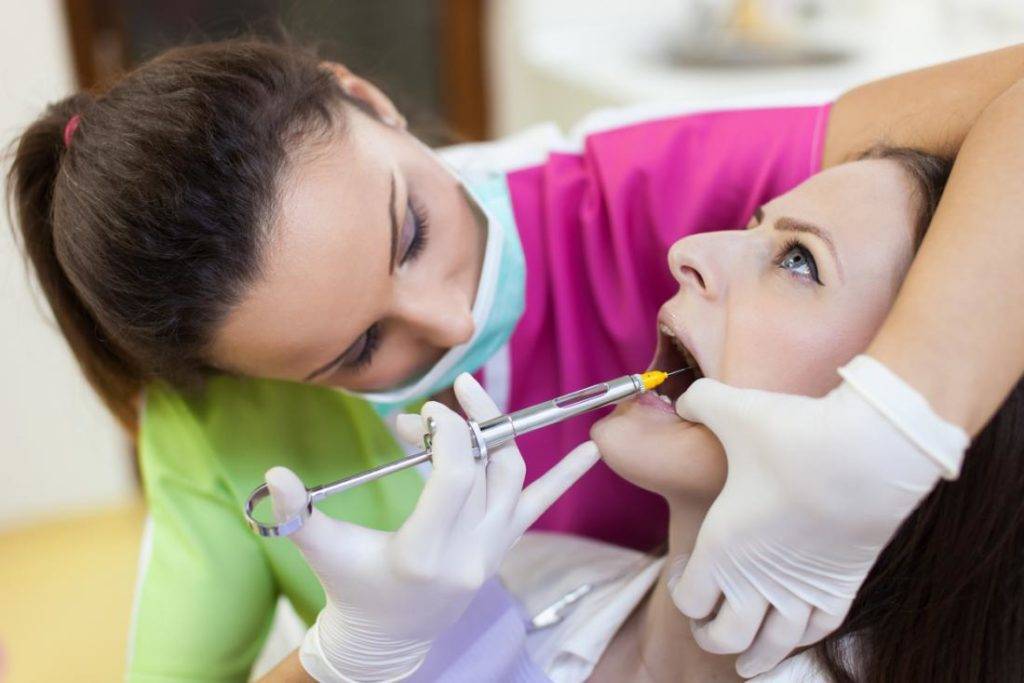Local Complications of Local Anaesthesia – Cause, Management, and Prevention of these Complications.
- Infection
- Injury to nerves
- Injury to vessels
- Trauma to muscles
- Needle breakage
- Intraglandular injections and their sequel
1. Infection
- ‘Needle track’ infection – contaminated needle or injection. Through contaminated tissue
- Contaminated solution-especially due to vials
- Break of aseptic technique
- Injecting LA into an area of infection by force or transfer bacteria into adjacent healthy tissue spreading infection.
2. Injury to nerves
- Even 25-30 gauge can cause paraesthesia by mere touching of nerve (neuropraxia).
- Hitting bone may ‘barb’ the tip & cause nerve damage on withdrawal (neurotmesis).
- Paresthesia -persistent anesthesia (anesthesia well beyond the expected duration), or altered sensation (tingling or itching) well beyond the expected duration of anesthesia.
- Hyperesthesia -increased sensitivity to noxious stimuli.
- Dysesthesia – painful sensation to non-noxious stimuli.
Paraesthesia
Neurovascular bundle can be traumatized by
- the sharp needle-tip, movement of the needle tip.
- extraneural or intraneural hemorrhage from trauma to the blood vessels.
- neurotoxic effects of the local anesthetic solution.
- Self-inflicted injury to oral tissues.
- Rx – reassure the patient.
- most cases resolve within eight weeks (Malamed1997).
- Oral B-complex with B12 and B6.
Pain
- Rapid injection insufficient time for diffusion pressure on nerve endings PAIN.
- Improper temp/pH of a solution.
- Contamination with sterilant/alcohol.
Failure to achieve profound anesthesia:
- Improper technique – too low or too anterior
- Insufficient volume
- Local infection
- Other neurological complications
Diffusion into orbit: ocular and extraocular symptoms
- regional sixth nerve block-paralysis of extraocular muscles-temporary diplopia.
- retrobulbar block (rare).
- optic nerve block, which can result in temporary blindness (amaurosis).
- Horner’s syndrome-like manifestations can occur, including enophthalmos, miosis, and palpebral ptosis.
3. Injury to vessels
- Nick of vessels – hematoma
- Arterial damage – rapidly expanding hematoma
- Prevention:
- Knowledge of anatomy
- Modify the tech. as dictated by patients anatomy
- Minimize the no. of needle penetration into tissues
- Never use a needle as a probe in the tissues
- Management:
- Direct pressure-intra/extra oral
- Usually self-limiting-observe over 48 hours
- Injection Tranexamic acid iv
- Arterial bleeds may require ligation
- Epithelial desquamation:
- Prolonged use of topical anesthetics
- High concentration of vasoconstrictors
- Most common on palatal mucosa
- Management
- Resolves in 7-10 days
- Mild NSAIDS
- Na bicarbonate, saline or Peridex mouth rinse
- Maybe a sequel of paraesthesia
4.Trauma to muscles
- Trismus – difficulty/inability to open the mouth
- Various mechanisms:
- Direct injury of temporalis and medial pterygoid muscle fibers by needle
- Intramuscular injection
- Rapid rate on injection
- Contaminated solution
- Wrong temperature/pH of the solution
- Prevention :
- Use a sharp, sterile, disposable needle
- Proper handling of local anesthetic solution.
- Not to contaminated needles
- Practice atraumatic technique
- Avoid repeat injection. And multiple injections.
- Use minimum effective volumes of LA.
- Management :
- Heat therapy ( after 2 days )
- Warm saline rinses.
- Analgesics, muscle relaxants.
- If it does not improve within 48-72 hrs, – infection must be considered — treat with antibiotics.
5. Needle breakage
- Causes :
- The weakening of dental needles by bending
- Sudden unexpected movements of the patient
- Inserting needle up to the hub
- Smaller gauge needles ( 30 gauge)
- Defective manufacturing
- Prevention :
- Use larger gauge needles
- Do not insert the needle into the tissue till the hub
- Do not redirect the needle once inserted into the tissue
- Excessive lateral force on the needle
- Management :
- DO NOT PANIC
- Ask the patient not to move or bite
- If the fragment is visible, try to remove it with a hemostat
- If the needle is not visible, do not proceed with incision or probing
- It can be removed immediately. only if it is superficial and easily located through radiological and clinical
- Examination.
- IN MANY INSTANCES IT IS REMOVED UNDER GA
6. Intraglandular injection
- IANB too posterior – injection within the parotid gland
- Block of CN7-Transient Facial nerve palsy
- Inability to blink/close eye
- Feeling of facial paralysis
- Rx-
- Reassure patient it is transient
- protect the cornea











One thought on “Local anesthesia: Uses, types, and risks”
where is the best dental clinic in mumbai for treatment of tooth extraction